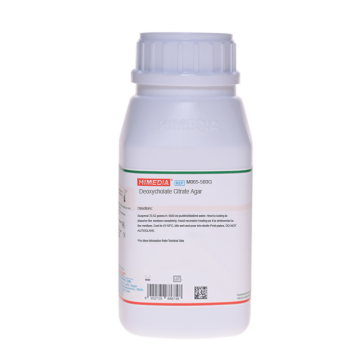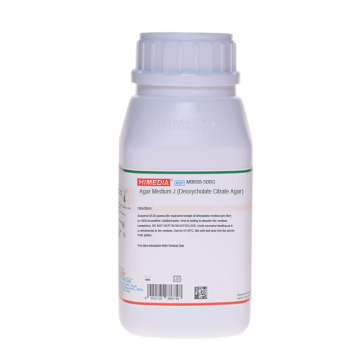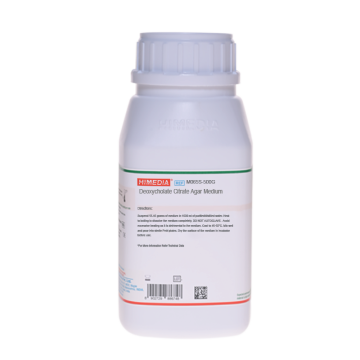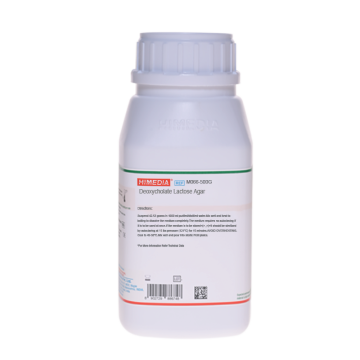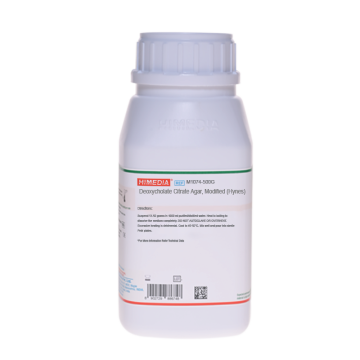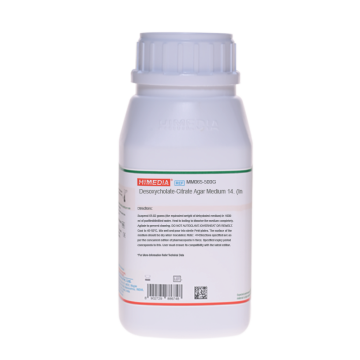 Your enquiry has been submitted
Your enquiry has been submitted
Deoxycholate Citrate Agar w/1.5% Agar
Intended Use
A selective medium recommended for the isolation of enteric pathogens.
Composition**
| Ingredients | g / L |
|---|---|
| HM peptone B | 5.000 |
| Peptone | 5.000 |
| Lactose | 10.000 |
| Sodium deoxycholate | 2.500 |
| Sodium citrate | 5.000 |
| Sodium thiosulphate | 5.000 |
| Ferric citrate | 1.000 |
| Neutral red | 0.025 |
| Agar | 15.000 |
Final pH (at 25°C): 7.0±0.2
**Formula adjusted, standardized to suit performance parameters
Directions
Suspend 48.52 grams in 1000 ml of purified / distilled water. Heat to boiling to dissolve the medium completely. DO NOT AUTOCLAVE. Avoid excessive or prolonged heating as it is detrimental to the medium. Cool to 45-50°C. Mix well and pour into sterile Petri plates.
Principle And Interpretation
Deoxycholate Lactose Agar is a modification of Deoxycholate Agar as described by Leifson (1) and prepared according to formula specified in Standard Methods for Examination of Dairy Products (2) Water and Waste Water (3) and Food (4) for the detection of coliform bacilli. It differs from Deoxycholate Agar (M030) by its decreased concentration of sodium deoxycholate. Deoxycholate Citrate Agar w/ 1.5% Agar is similar to but less selective and inhibitory than Deoxycholate Lactose Agar. However, the colonial characteristics are identical on the two media. The less inhibitory media is often preferable when Shigella are being sought as well as Salmonella (4).
HM peptone B and peptone serves as the sources of essential nutrients. Coliforms as well as gram-positive bacteria are greatly suppressed due to the presence of sodium deoxycholate, sodium citrate and ferric citrate. Lactose is the fermentable carbohydrate in the medium. Lactose fermenters utilize lactose and produce acidic conditions around the lactose fermenting colony. This acidity causes the pH indicator, neutral red, to change its colour to red. These colonies usually are also surrounded by a turbid zone of precipitated deoxycholic acid due to acidification of the medium. Sodium deoxycholate combines with neutral red in an acidic environment, causing the dye to go out of the solution with the subsequent precipitation of deoxycholate (5).
The reduction of sodium thiosulphate to sulfide is indicated by the formation of black iron sulfide. Salmonella and Shigella species do not ferment lactose but Salmonella may produce H2S forming colorless colonies with or without black centers. Citrate and iron (Fe) combination has a strong hydrolyzing effect on agar when the medium is heated, producing a soft and unelastic agar. If autoclaved the agar becomes soft and almost impossible to streak (5).
Type of specimen
Clinical- faeces; Water samples.
Specimen Collection and Handling
For clinical samples follow appropriate techniques for handling specimens as per established guidelines (3,4). For water samples, follow appropriate techniques for sample collection, processing as per guidelines and local standards (1). After use, contaminated materials must be sterilized by autoclaving before discarding.
Warning and Precautions
In Vitro diagnostic use. For professional use only. Read the label before opening the container. Wear protective gloves/protective clothing/eye protection/face protection. Follow good microbiological lab practices while handling specimens and culture. Standard precautions as per established guidelines should be followed while handling clinical specimens. Safety guidelines may be referred in individual safety data sheets.
Limitations
- Further biochemical identification is required for confirmation of species.
- Due to nutritional variations some organisms may show poor growth.
Performance and Evaluation
Performance of the medium is expected when used as per the direction on the label within the expiry period when stored at recommended temperature.
Quality Control
Appearance: Light yellow to pink homogeneous free flowing powder
Gelling: Firm, comparable with 1.5% Agar gel
Colour and Clarity of prepared medium: Reddish orange coloured, clear to slightly opalescent gel forms in Petri plates
Reaction: Reaction of 4.85% w/v aqueous solution at 25°C. pH : 7.0±0.2
pH: 6.80-7.20
Cultural Response: Cultural characteristics observed after an incubation at 35-37°C for 18-24 hours.
| Organism | Inoculum (CFU) | Growth | Recovery | Colour of colony |
|---|---|---|---|---|
| Bacillus subtilis subsp. subtilis ATCC 6633 (00003*) | >=104 | inhibited | 0% | |
| Escherichia coli ATCC 25922 (00013*) | 50-100 | good-luxuriant | >=50% | pink w/bile precipitate |
| # Klebsiella aerogenes ATCC 13048 (00175*) | 50-100 | good - luxuriant | >=50% | pink |
| Enterococcus faecalis ATCC 29212 (00013*) | >=104 | inhibited | 0% | |
| Salmonella Typhimurium ATCC 14028 (00031*) | 50-100 | good-luxuriant | >=50% | colourless |
Key : (*) Corresponding WDCM numbers. (#) Formerly known as Enterobacter aerogenes
Storage and Shelf Life
Store between 10-30°C in a tightly closed container and the prepared medium at 20-30°C. Use before expiry date on the label. On opening, product should be properly stored dry, after tightly capping the bottle in order to prevent lump formation due to the hygroscopic nature of the product. Improper storage of the product may lead to lump formation. Store in dry ventilated area protected from extremes of temperature and sources of ignition Seal the container tightly after use. Product performance is best if used within stated expiry period.
Disposal
User must ensure safe disposal by autoclaving and/or incineration of used or unusable preparations of this product. Follow established laboratory procedures in disposing of infectious materials and material that comes into contact with clinical sample must be decontaminated and disposed of in accordance with current laboratory techniques (6,7).
Reference
- E. Leifson, New culture media based on sodium deoxycholate for the isolation of intestinal pathogens and for the enumeration of colon bacilli in milk and water., J. Path. Bact., 40, 581 (1935).
- Richardson, (Eds.), 1985, Standard Methods for the Examination of Dairy products, 15th Ed. APHA, Washington,D.C.
- Lipps WC, Braun-Howland EB, Baxter TE,eds. Standard methods for the Examination of Water and Wastewater, 24th ed. Washington DC:APHA Press; 2023.
- Speck M. L., (Ed.), 1984, Compendium of Methods for the Microbiological Examination of Foods, 2nd Edition DI. APHA,Washington, D.C.
- MacFaddin, J.F., (1985). Media for Isolation-Cultivation-Identification-Maintenance of Medical Bacteria. Vol. 1. Williams andWilkins.Baltimore,Maryland.
- Isenberg, H.D. Clinical Microbiology Procedures Handbook 2nd Edition.
- Jorgensen, J.H., Pfaller, M.A., Carroll, K.C., Funke, G., Landry, M.L., Richter, S.S and Warnock., D.W. (2015) Manual of Clinical Microbiology, 11th Edition. Vol. 1.Leifson, 1935, J. Path. Bact., 40:581.
| Product Name | Deoxycholate Citrate Agar w/1.5% Agar |
|---|---|
| SKU | M1639 |
| Product Type | Regular |
| Physical Form | Powder |
| Origin | Animal |
| Packaging type | HDPE |
| References | 1.Leifson, 1935, J. Path. Bact., 40:581. |
| Customized Product Available | No |








